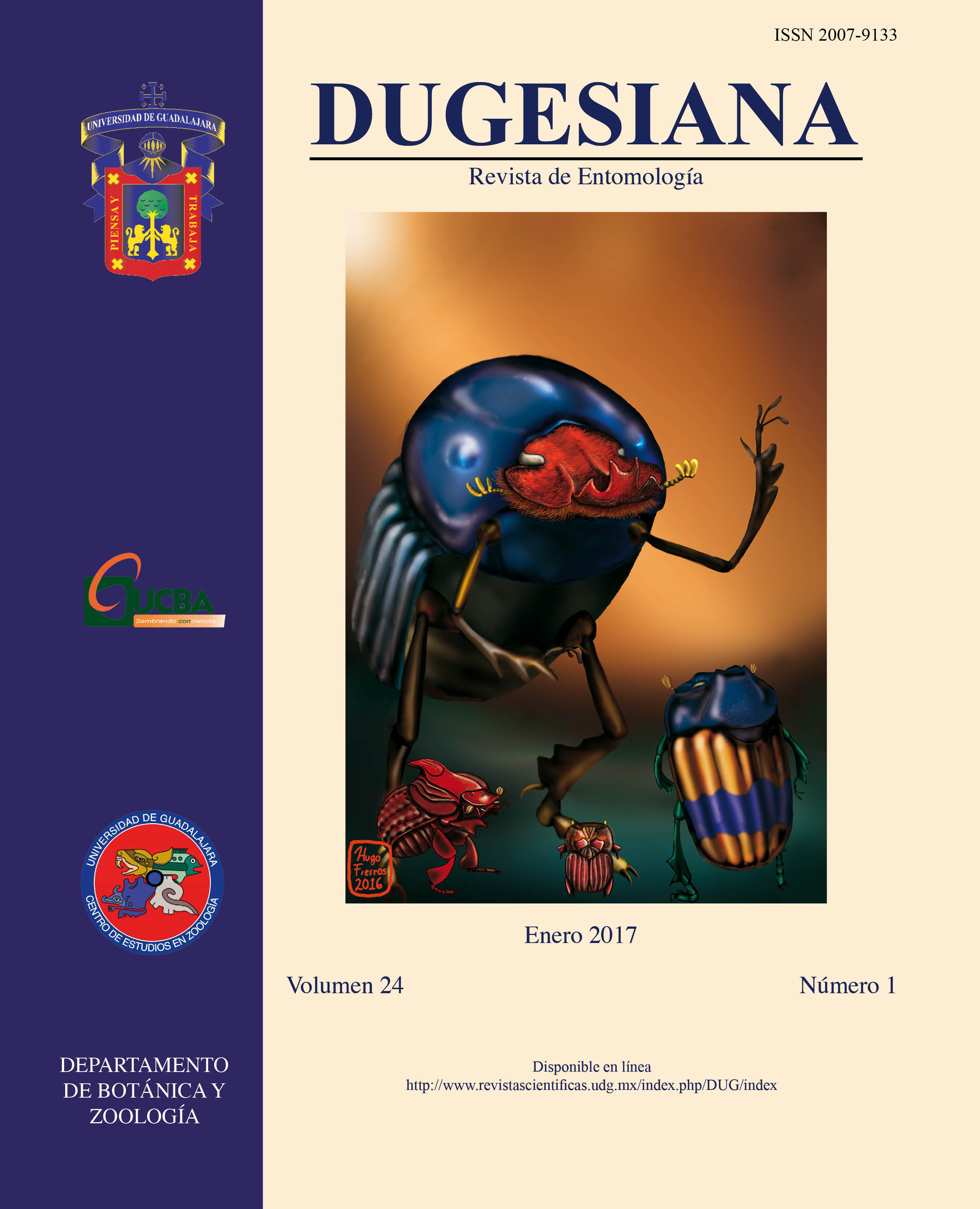First record of the genus <em>Arisemus</em> Satchell in Mexico, with description of <em>Arisemus imeldae</em> sp. nov. (Diptera: Psychodidae)
DOI:
https://doi.org/10.32870/dugesiana.v24i1.6219Keywords:
Psychodinae, new species, description, morphology, taxonomy.Abstract
A new species of psychodid moth fly of the genus Arisemus from Mexico is described based on male and female characteristics. Arisemus imeldae sp. nov. is the first species of this genus reported in Mexico. Specimens were collected near Xalapa city, in the center of the state of Veracruz, Mexico. The male presents a nearly symmetrical long aedeagus and short parameres, gonostylus simple with cluster of few sensilla; female hypovalvae with lobes scarcely separated and posterior portion of genital chamber with wide curved rods, characters that distinguish the species from all other previously described.References
Botosaneanu, L. & Vaillant, F. 1970. Trois diptéres psychodidae nouveaux de Cuba. Travaux du Laboratoire d’Hydrobiologie et de Pisciculture de l’Université de Grenoble, 61: 173-183.
Bravo, F. & Araújo, M. X. 2013. Two new species of moth flies (Diptera, Psychodidae) from the semi-arid region of Brazil. Zootaxa, (3693 [1]): 85-90.
Collantes, F. & Baquero, E. 2000. First Record of the Subfamily Psychodinae (Diptera: Psychodidae) from Ecuador. Aquatic Insects, 23(4): 277–281.
Collantes, F. & Martínez-Ortega, E. 1999. A New Species of Moth-fly Belonging to Genus Arisemus Satchell, from Nicaragua (Diptera, Psychodidae). Aquatic Insects, 21(3): 215–219.
Curler, G. R. & Moulton, J. K. 2012. Phylogeny of psychodid subfamilies (Diptera: Psychodidae) inferred from nuclear DNA sequences with a review of morphological evidence of relationships. Systematic Entomology, 37(3): 603-616.
Duckhouse, D. A. 1987. A revision of Afrotropical Setomima, elucidation of their genealogical relationships and descriptions of other Afrotropical Psychodinae (Diptera, Psychodidae). Annals of the Natal Museum, 28(2): 231-282.
Enderlein, G. 1937. Klassification der Psychodiden (Diptera). Deutsche Entomologische Zeitschrift, 1936: 81-112.
Dugesiana
Ježek, J., Le Pont, F., Martínez, E. & Mollinedo, S. 2011. Three new species of non-biting moth flies (Diptera: Psychodidae: Psychodinae) from Bolivia, with notes on higher taxa of the subfamily. Acta Entomologica Musei Nationalis Pragae, 51(1): 183-210.
Kotrba, M. 2000. Morphology and terminology of the female postabdomen (pp. 75-84). In: Papp, L. & Darvas, B. (Eds.). Contributions to a Manual of Palaearctic Diptera. Vol. 1. Science Herald, Budapest.
Merz, B. & Haenni, J-P. 2000. Morphology and terminology of adult Diptera (other than terminalia) (pp. 21-51). In: Papp, L. & Darvas, B. (Eds.). Contributions to a Manual of Palaearctic Diptera. Vol. 1. Science Herald, Budapest.
Müller, F. 1895. Contribution towards the history of a new form of larvae of Psychodidae (Diptera) from Brazil. Transactions of the Entomological Society of London, 1895: 479-482, pls.10-11.
Quate, L. W. 1996. Preliminary taxonomy of Costa Rican Psychodidae (Diptera), exclusive of Phlebotominae. Revista de Biología Tropical, 44 (Suppl. 1): 1-81.
Quate, L.W. & Brown, B.V. 2004. Revision of neotropical Setomimini (Diptera: Psychodidae: Psychodinae). Contribution in Science: Natural History Museum of Los Angeles County, (500): 1–117.
Satchell, G. H. 1955. Two new subgenera of Psychodidae (Diptera) from Jamaica, with descriptions of five new species. Annals and Magazine of Natural History (12), 8: 85-93.
SEFIPLAN (Secretaría de Finanzas y Planeación del Estado de Veracruz). 2015. Emiliano Zapata. Sistema de Información Municipal. Cuadernillos municipales. On line: http://www.veracruz.gob.mx/finanzas/ files/2015/05/Emiliano-Zapata.pdf (visited: September 22, 2016).
Vaillant, F. 1982. Les tribes de la sous-famille des Psychodidae: Psychodinae (Diptera). Nouvelle Revue d’Entomologie, 12(2): 189-194.
Vaillant, F. 1990. Propositions pour une revision de la classification des Diptères Psychodidae Psychodinae. Bulletin de la Société Vaudoise des Sciences Naturelles, 80(2): 141-163.
Wagner, R. & Joost, W. 1994. On a Small Collection of Psychodidae (Diptera) from Colombia. Studies on Neotropical Fauna and Environment, 29(2): 75–86.
Wagner, R. & Masteller, E. C. 1996. New moth flies (Diptera: Psychodidae) and a key to species from Puerto Rico. Proceedings of the Entomological Society of Washington, 98(3): 450-464 20.
Additional Files
Published
Issue
Section
License
1. Proposed policy for open access journals
Those authors who have publications with this journal, accept the following terms:
- The authors will retain their copyright and will guarantee to the journal the right of first publication of their work, which will be simultaneously subject to the Creative Commons Recognition License, which allows third parties to share the work whenever their author is indicated and His first publication is this journal.
- Authors may adopt other non-exclusive license agreements to distribute the version of the published work (eg to be deposited in an institutional telematic file or published in a monographic volume) provided the initial publication is indicated in this journal .
Authors are encouraged and encouraged to disseminate their work through the Internet (eg in institutional telematic files or on their web page) before and during the sending process, which can produce interesting exchanges and increase appointments Of the published work. (See The effect of open access).
2. Proposed policy for journals that offer open deferred access
Those authors who have publications with this journal, accept the following terms:
- The authors will retain their copyrights and will guarantee to the journal the right of first publication of their work [SPECIFY PERIOD OF TIME], which will be simultaneously subject to the Creative Commons Recognition License that allows third parties to share the work always That its author and his first publication be indicated this journal.
- Authors may adopt other non-exclusive license agreements to distribute the version of the published work (eg to be deposited in an institutional telematic file or published in a monographic volume) provided the initial publication is indicated in this journal .
- Authors are encouraged and encouraged to disseminate their work through the Internet (eg in institutional telematic files or on their web page) before and during the sending process, which can produce interesting exchanges and increase appointments Of the published work. (See The effect of open access).




